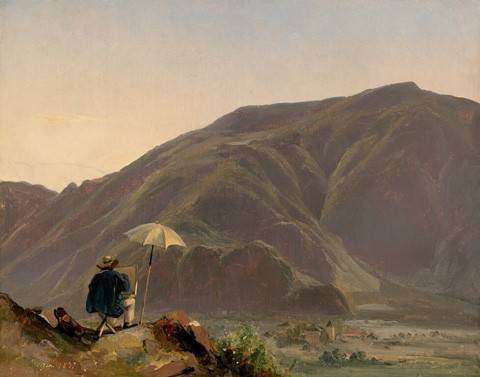
Jules Coignet, “View of Bozen with a Painter”, 1837, oil on paper, mounted on canvas. Gift of Mrs. John Jay Ide in memory of Mr. and Mrs. William Henry Donner.
Open-Air Painting in Europe at NGA ‘True to Nature: Open-Air Painting in Europe, 1780–1870’ presents some 100 oil sketches made outdoors across Europe by artists such as Carl Blechen, Jules Coignet, André Giroux, Anton Sminck Pitloo, Carl Frederik Sørensen, and Joseph Mallord William Turner. National Gallery of Art, Washington, from February 2 through May 3, 2020.]]>
Source: National Gallery of Art, Washington
True to Nature begins as European artists would have in the late 18th and early 19th century—in Rome. The study of ancient sculpture and architecture, as well as of Renaissance and baroque art, was already a key part of an artist’s education, but Pierre-Henri de Valenciennes’s influential treatise on landscape painting, published in 1800, went further to recommended that young artists develop their skills by painting oil sketches out of doors. Valenciennes advised exploring the Roman countryside, as he had in “Study of Clouds over the Roman Campagna” (c. 1782/1785). This section includes examples by a range of European artists who followed his advice, such as Michel Dumas, Christoffer Wilhelm Eckersberg, and Johan Thomas Lundbye. Also included is “The Island and Bridge of San Bartolomeo, Rome” (1825/1828) by Jean-Baptiste-Camille Corot. Corot was a key figure in 19th-century landscape painting, bringing the practice of open-air painting back to France and inspiring a younger generation of impressionist painters.
Other sections focus on both natural and man-made features that proved challenging to painters, such as waterfalls, trees, skies, coastlines, and rooftops. Examples include rare studies by well-known artists such as John Constable’s “Sky Study with a Shaft of Sunlight (c. 1822, Fitzwilliam Museum), Jean Honoré Fragonard’s “Mountain Landscape at Sunset (c. 1765), and Odilon Redon’s “Village on the Coast of Brittany” (1840–1916, Fondation Custodia) as well as sketches by lesser-known painters like Louise-Joséphine Sarazin del Belmont, one of the few known women artists active during this period. True to Nature illustrates how pervasive plein-air painting became across Europe with examples by many Belgian, Danish, Dutch, German, Swiss, and Swedish artists who studied in Italy before returning home to paint their native surroundings. Sketches by Carl Blechen include an example from his time in Italy, “View of the Colosseum in Rome” (1829, Fondation Custodia), as well as a study made at home in Germany, “View of the Baltic Coast” (1798-1840, Fondation Custodia).
Related content
50 great landscape paintings
Follow us on:


